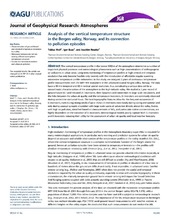Analysis of the vertical temperature structure in the Bergen valley, Norway, and its connection to pollution episodes
Peer reviewed, Journal article
Published version

Åpne
Permanent lenke
https://hdl.handle.net/1956/9478Utgivelsesdato
2014-09Metadata
Vis full innførselSamlinger
- Geophysical Institute [1197]
Originalversjon
https://doi.org/10.1002/2014jd022085Sammendrag
The vertical temperature profile in the lowest 1000m of the atmosphere determines a number of important physical processes and meteorological phenomena such as high concentrations of anthropogenic air pollutants in urban areas. Long-term monitoring of temperature profiles at high vertical and temporal resolution has only become feasible only recently with the introduction of affordable angular scanning microwave temperature profile radiometers. In this study, we analyzed 2 years of continuous temperature profile measurements with the MTP-5HE instrument in the urbanized coastal Bergen valley, Norway. The data have a 10min temporal and 50m vertical spatial resolution, thus, constituting a unique data set for a microclimatic characterization of the atmosphere in this high-latitude valley. We studied a 2 year record of ground-based (G-) and elevated (E-) inversions, their dynamics and connection to large-scale circulations, and the links between the urban air quality and the temperature inversions. G-inversions are commonly observed during wintertime nocturnal hours. The local topographic features allow for the frequent occurrence of G-inversions, even during strongwinds of up to 16m/s. E-inversions existmostly during spring and summer and only during unusual synoptic circulation with large-scale warm air advection directly above the valley. Events with high air pollution, identified based on measurements of NO2 and particulate matter concentrations, are highly dependent on the existence of G-inversions. Meteorological models poorly capture both G-inversions and E-inversions reducing their utility for the assessment of urban air quality and local weather forecasts.
Utgiver
WileyAmerican Geophysical Union
